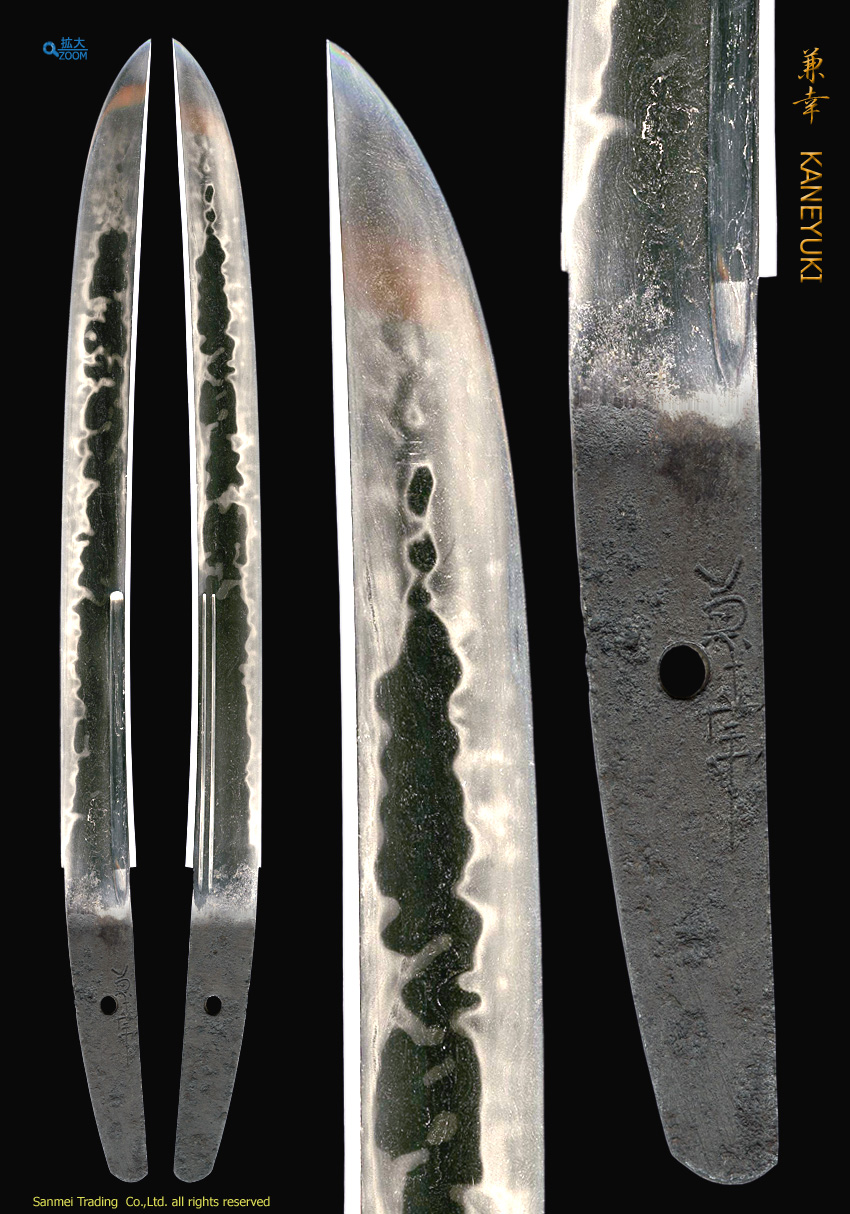Length of cutting edge 29.6cm Curvature 0.3cm Width of base 26.7mm Thickness of base 6.8mm
Carving(Horimono) : Bo-hi groove in front and Gomabashi a pair of thinner grooves in the other side.
Forging pattern (kitae hada) : Kitae hada is conspicuous Itame mixing with flowing Masame-hada ware along back ridge of Mune side. The surface is covered in Ji-nie (hard metal granules over the surface) with abundant Chikei (darkish Nie lines) activity. Speckled sparkling reflection so called Yubashiri clearly appears entirely from base to tip on Hiraji.
Tempering pattern (hamon) : Quenching line is covered with a bit on stronger side of Nie. Uniform fine Nioi granules of frog is perceived in the interior of temper where abundant Ashi and floating YOU also expansive long lines of NieSunagashi are clearly perceived.
Flamboyant HITATSURA hamon consists of undulating Choji-ha, small Togari-ha, Notch of an arrow shape Gunome, splashed Tobiyaki and Muneyaki along back ridge.
Temper of tip (boshi) : Temper of tip becomes stronger the Nie granules, brighter the Nioi, forms an irregular IACHIMAI and turns back deeply that connects to Muneyaki.
Tang (Nakago) : Nakago is relatively large. Uneven U-shaped Kurijiri bottom shape. Nakago is UBU that hold slight curve, unaltered. Crossing Higaki file marks. One large retaining hole of Mekugi-ana. The classical signature is inscribed in front 2 character KANEYUKI 兼幸.
The subject tanto is the superb example work by KANEYUKI 兼幸 that belonged to the medieval temple estate Hachiya 蜂屋, eastern suburb of Seki 関.
According to Nihonto Meikan, founder KANEYUKI 兼幸, a son of KANESADA 兼貞, was active during Daiei era (1521-27) and his follower 2nd KANEYUKI 兼幸 is from Tenbun era (1532-54).
Well harmonized curve was designed for fast draw, Hirazukuri-construction was working well for cutting through the openings of armor or helmet, Itame forging ware of functional mixture with hard and soft steel was designed for durable construction, Hitatsura quenching method was carefully designed for the most supreme sharp performance and Muneyaki was aimed for defending against hard hitting.
This prominent tanto has been treasured by powerful legitimate Samurais in generations and deeply admired for the excellent quality of the risen Mino-den bearing legitimate Sōshu technique that remains excellent condition over the passage of almost 500 years.
It is full of Samurai majesty spirit during the Warning States of period when major powerful clans such as Oda or Toyotomi in Owari, Tokugawa in Mikawa, Imagawa in Suruga, Takeda in Kai and Hōjo in Odawara began rise to power.
Single layer gold plated silver Habaki collar, preserved in a Shira-saya plain wood mounting. There is insignificant scratches due to old polish.
Good old polish/Condition scale: excellent-very good (using a scale of mint-excellent-very good-good-fair-poor)
reference data: Honma Kunzan/Ishii Masakuni, NihontoMeikan, Yuzankaku, 1975


